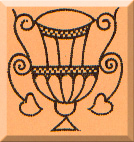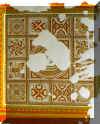
 |
ASPROM | |||||||||||||||||||
The Association for the Study and Preservation of Roman Mosaics |
||||||||||||||||||||
| About ASPROM | News & Events | Publications | Mosaics in Britain | Resources | Join ASPROM | |||||||||||||||
 |
| Fig. 1: The Whitley Grange mosaic (painting by David S. Neal). |
The mosaic discovered at Whitley Grange in 1995 occupied the central room of the main villa, which had narrow reception rooms on each side and a south-east facing porticus. To the north lay an imposing bath-house, appreciably larger than the 'residential' building. The south end of the structure was terraced slightly into the uphill slope so the northern half of the floor had shallower deposits than the south. Apart from the central area of the mosaic, which had been damaged by hearths in antiquity and modern plough scars, the mosaic was fairly well preserved but, due to the acid soils, most of the white limestone tesserae were lost. However, in places, where deposits of destruction rubble and lime mortar lay deeper these had helped neutralise the acid conditions so that here the white limestone tesserae were preserved. Part of the mosaic on the north side had also moved from its original position. The survey shows the mosaic as if all the white tesserae survived and shows the displaced section in its correct location.
The room measures about 6.00 m by 5.50 m and the mosaic 4.35 m square (area of fine tesserae only, and excluding coarse decorated borders). Its scheme is based on a four by four grid of squares drawn in simple guilloche outlined grey, with white, green and red strands (these colours are used throughout the pavement) but with the four central squares combined to create a large single square. Within this is a series of concentric circular bands including, working inwards, red inward-facing stepped triangles, four-strand guilloche (in the same colours as elsewhere), and a shaded band. The central medallion was originally occupied by a bust of Medusa which faced the viewer at the north-west end of the room. The figure was much damaged with only some grey tesserae surviving including some of her sinuous upstanding hair and part of the forehead, eye and nose. It is unfortunate that the bust is so poorly preserved but its linear treatment is typical of other examples in Britain including the mosaic from Room 6, Bignor, Sussex.[1] The spandrels between the concentric bands and the guilloche square are outlined with a single grey fillet and shaded concentrically red, green and white, with a red triangle in the centre.
Of the twelve guilloche squares around the centre, these contain five varieties of motifs all with a linear frame. In each corner square are circles of shaded bands containing a linear circle and a guillloche knot further outlined by a grey line. The remaining pairs of motifs lay opposite one another and include, on the east and west sides, an imaginative arrangement of peltae shaded concentrically green, grey, red and white with three interlaced circles in the centre. Next to these are flowers composed of four very large red-tipped heart-shaped leaves with sinuous stalks which thicken and curl outward into the corners of the panels. On the north and south sides are medallions containing a pattern of eight running heart-shaped petals set around concentric circles of grey, white, green and red. In spandrels outside the medallions are grey spirals. Next to these are highly stylised canthari with spiralled handles and with V-shaped patterns shaded red and white on their necks. Sinuous stalks bearing heart-shaped petals spring from their rims and bases.
Surrounding the mosaic is a coarse tessellated border composed of a band of green, red outward-pointing stepped triangles, a band of red and further bands of green and red; the south-east side of the floor, nearest the entrance, has a wider area of plain coarse red tessellation.
The coffered scheme with a large square in the centre, as represented at Whitley Grange, has no precise parallel in Britain but can be seen in its basic form, for example, on a late second century mosaic from Building I V, 8, Verulamium.[2] Here sixteen panels, arranged as a four by four grid, reflect the form of a coffered ceiling with medallions within the squares representing bosses, but unlike the mosaic under discussion no large square central panel has been introduced. Another mosaic with this scheme, but with nine panels arranged as a three by three grid and paving part of a bipartite room, occurs at Frampton, Dorset.[3] Here the corner panels contain roundels with personifications of the Winds and the mosaic is of fourth century date. However, the scheme is more commonly adapted to create a large central square with rectangles on each side and with smaller squares in the angles. Examples can be found at many sites and range in date from the second to the fourth centuries; the cantharus from Verulamium[4] may be cited.
However, although no close parallel for the scheme can be found this does not apply to the ornament which has an artistic spontaneity with a distinctive, imaginative style to be seen in the varied adaptations of heart-shaped petals. They adorn the highly stylised canthari, are enlarged to create a four-petalled flower and also occur as running hearts in two of the roundels. There can be little doubt that the mosaic found at Ewefields Farm, Chesterton, Warwickshire, in 1994 is by the same mosaicist.[5] This mosaic probably paved a porticus, and has large right-angled triangles and at least one poised square, all containing a wide variety of motifs composed of heart-shaped petals including running examples set tip to base, a spiral in the form of a Catherine wheel and as general fillers, with examples accompanying three interlaced circles such as occur on two panels on the Whitley Grange mosaic. The similarities between these mosaics strongly suggest the work of a group of mosaicists not identified previously. A mosaic found at Wroxeter in 1706[6] may be the work of the same contractors. This comprises a square of simple guilloche enclosing a large, unusual flower with four oval leaves concentrically shaded with their tips extending into the corners of the panel. Separating each panel are inward-pointing petals with red tips. A distinctive feature of the mosaic is the use of circular shaded bands set in reticulated tesserae occupying the compartments in the corners. The use of shaded bands is uncommon, but occurs, for example, as far afield as Room 15, Colliton Park, Dorchester;[7] encircling a male bust on a mosaic from Room 13, Lufton, Somerset;[8] and bordering two of the Four Seasons on the Charioteer mosaic as far north as Rudston, Yorkshire,[9] and their presence does not indicate related products.
![]() Read more about the villa at Whitley Grange.
Read more about the villa at Whitley Grange.
Notes | |
| 1 | Lysons, S., Reliquiae Britannico-Romanae III (1817), pl. XXVIII. |
| 2 | Wheeler, R. E. M. & Wheeler, T. V., A Belgic and Two Roman Cities, Reports of the Research Committee of the Society of Antiquaries of London, No. XI (1936), pl. XLII. |
| 3 | Lysons, S., Reliquiae Britannico-Romanae I, iii (1813), pl. IV. |
| 4 | Neal, D. S., Roman Mosaics in Britain. An Introduction to their Schemes and a Catalogue of Paintings, Britannia Monograph series No. 1 (1981), mosaic 73. |
| 5 | Neal, D. S. & Cosh, S. R., Roman Mosaics in Britain, vol. I, Northern Britain Incorporating the Midlands and East Anglia (forthcoming). |
| 6 | Dukes MS, preserved in the Library of the Society of Antiquaries of London. |
| 7 | RCHM, An Inventory of Historical Monuments in the County of Dorset, vol. II, South-East, pt. 3 (1970), 555, pl. 218. |
| 8 | Hayward, L. C.,’The Roman villa at Lufton near Yeovil’, Proceedings of the Somerset Archaeological and Natural History Society (1972), 73–5, pl. V. |
| 9 | Neal, D. S., Roman Mosaics in Britain. An Introduction to their Schemes and a Catalogue of Paintings, Britannia Monograph Series No. 1 (1981), mosaic 69. |
| © David S. Neal 1997. This article was originally published in Mosaic 24 (1997) 18–19. |